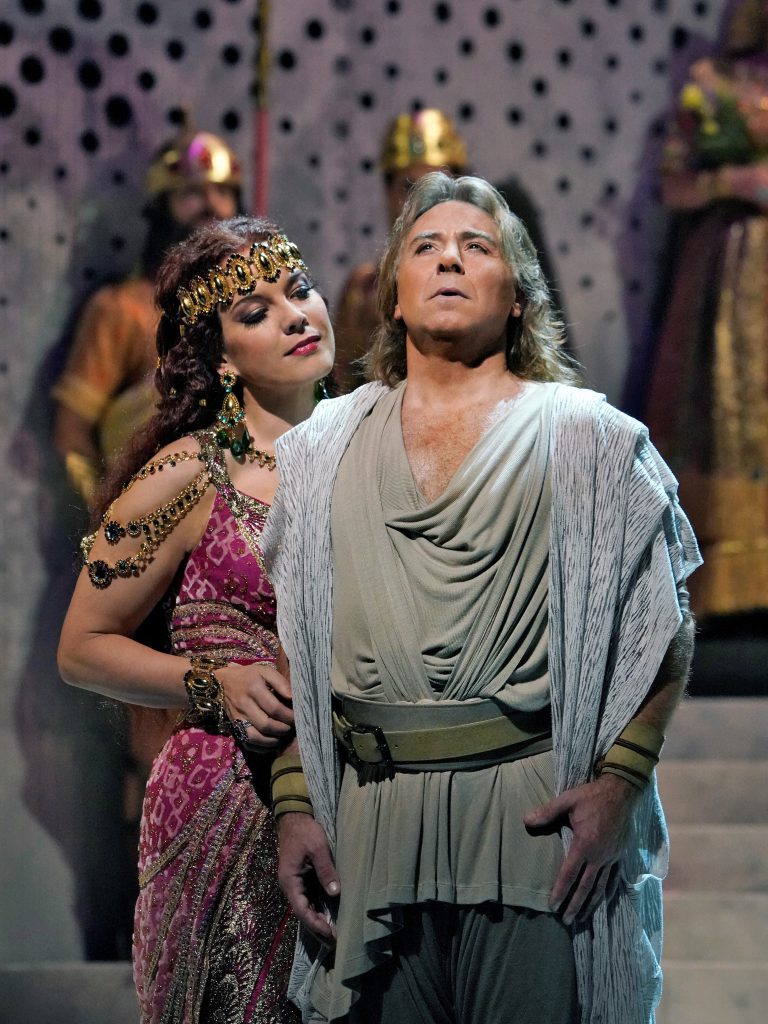A magnetic Garanča simmers in Met’s season-opening “Samson et Dalila”

Elīna Garanča and Roberto Alagna star in the Metropolitan Opera’s new production of Saint-Saëns’ “Samson et Dalila.” Photo: Ken Howard
The Met has taken a varied approach to opening-night planning in recent years. Cerebral regietheater productions have been folded in among fluffy farces and nimble adaptations of masterworks.
The company opened its 2018–19 season Monday night with Camille Saint-Saëns’s Samson et Dalila, whose massive scenes and biblical setting certainly provide the potential for a colorful opening-night splash.
In the end, though, the Met’s production does little to explore the imaginative possibility of its subject. Here, the biblical tale of war, seduction, and revenge rolls along without much spark, providing a few moments of flash but failing to capture the legendary scale of the story.
The debut Met effort of Yugoslav director Darko Tresnjak leaned toward the blandly gaudy. Puffy costumes by Linda Cho point in the general direction of antiquity, and Alexander Dodge’s sets, though more stylized, are not much more enlightening. What’s more, they seem constructed with such specific camera shots in mind for the Live in HD series—now have the mezzo stand in the big circular portal in the center, now have her stand precisely between the two huge braziers stage right—that it will be impossible for future singers to do anything but the original blocking.
Tresnjak’s vision clarifies somewhat in Act III, where we discover the blinded Samson in captivity. The first scene of the act is the most visually striking presentation of the production, a grindstone the only feature in his cold cell, a vivid symbol of his heavy solitude. The transition to the second scene is impressive as well, suddenly blinding with opulent red and gold, presenting the hard-partying Philistines in their wild final Bacchanale before they are all destroyed with their temple. It’s not exactly subtle—the barely-clad dancers convulsing around an enormous gold idol could just as easily find a home in Vegas as in ancient Gaza—but it is effective.
The Met has assembled a starry cast of A-list singers, who delivered mostly excellent performances. Roberto Alagna, who has been one of the premier tenors of the last few decades, still has a great deal to offer audiences, but he simply has no top any more. This has been evident in several of his most recent Met appearances (Cavalleria and Pagliacci, Manon Lescaut, Cyrano de Bergerac) and was true Monday night, as well. His quick bail-out when he faltered on the B-flat at the close of the opera was only the most prominent of a number of instances.
That’s a problem worth enduring for what Alagna can still bring to his performances: dramatic commitment and a colorful, if now somewhat brawny, tenor. “Vois ma misère, hélas!,” Samson’s wrenching aria at the top of Act III, was a prime example of Alagna at his best, where his subtle musical sense led to a gorgeous dialogue with the sighs of the orchestra.
The star, as she so often is, was Elīna Garanča as Dalila. The Latvian mezzo brings brilliant energy and magnetic presence to every role she approaches. She somewhat overplayed the seductress angle in her first scene, trying to win over the victorious Samson, but coming off too cold to convince the audience. Fully in evidence, though, was her remarkable consistency of tone: cool amber in her middle and top, burning power in her chest, and focus from top to bottom.
“Mon coeur s’ouvre à ta voix” is justly the most celebrated aria of the piece: its vocal line is gorgeously written, and as in many of the opera’s intimate moments, the orchestra mostly recedes, allows the singers to have pride of place. This was a stunning interpretation by Garanča, with long, breathing phrases, giving the music a slow-burning sensuality to match the scene.
One can imagine a more bellowing voice in the role of the High Priest, but Laurent Naouri’s warm bass-baritone fit nicely. His singing is more about tone and texture than pure power, and there’s an intensity in his wooly sound even if it’s not cavernous. He was a commanding presence onstage, and the interplay between him and the orchestra in his Act II encounter with Dalila was thrilling.
The Satrap Abimelech doesn’t last long, but Elchin Azizov made an impression before his quick dispatching in Act I, bringing a strong, clear baritone, robust without being heavy. Dmitry Belosselskiy had even less to do as the Old Hebrew, and felt over-cast, briefly showing off a powerful, colorful bass, albeit testing the bottom of his range.
Much of the credit for Monday’s success is owed to the work of Mark Elder in the pit. He has a natural feel for the color of Saint-Saëns’s music, color, even if his tempi tended toward the slower side. Under his direction, the Met orchestra brought richness and volume where required, but were content to get out of the way of the singers to let intimate moments breathe. The Met Chorus, called on so often in this opera, were brilliant, showing fullness of sound whether whispering or blaring.
Samson et Dalila runs through March 28 at the Metropolitan Opera. A second cast, starring Anita Rachvelishvili and Aleksandrs Antonenko, opens on March 13. metopera.org



Posted Sep 25, 2018 at 1:14 pm by Oscar Rivero
I was in Paris when Anita and Antonenko performed !areal french opera.this i listened at the radio really disappointing.